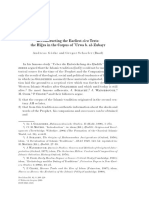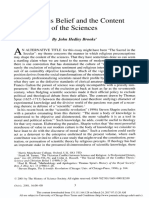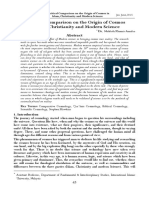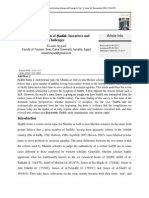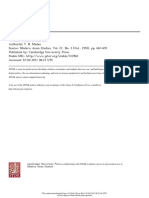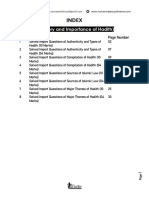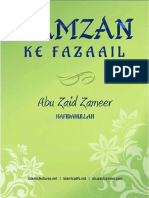Professional Documents
Culture Documents
Wael Hallaq, 1999
Wael Hallaq, 1999
Uploaded by
Aisyah AyeshaCopyright
Available Formats
Share this document
Did you find this document useful?
Is this content inappropriate?
Report this DocumentCopyright:
Available Formats
Wael Hallaq, 1999
Wael Hallaq, 1999
Uploaded by
Aisyah AyeshaCopyright:
Available Formats
Maisonneuve & Larose
The Authenticity of Prophetic Ḥadîth: A Pseudo-Problem
Author(s): Wael B. Hallaq
Source: Studia Islamica, No. 89 (1999), pp. 75-90
Published by: Maisonneuve & Larose
Stable URL: http://www.jstor.org/stable/1596086 .
Accessed: 15/08/2013 17:38
Your use of the JSTOR archive indicates your acceptance of the Terms & Conditions of Use, available at .
http://www.jstor.org/page/info/about/policies/terms.jsp
.
JSTOR is a not-for-profit service that helps scholars, researchers, and students discover, use, and build upon a wide range of
content in a trusted digital archive. We use information technology and tools to increase productivity and facilitate new forms
of scholarship. For more information about JSTOR, please contact support@jstor.org.
Maisonneuve & Larose is collaborating with JSTOR to digitize, preserve and extend access to Studia Islamica.
http://www.jstor.org
This content downloaded from 92.236.142.67 on Thu, 15 Aug 2013 17:38:08 PM
All use subject to JSTOR Terms and Conditions
Studia Islamica, 1999
of Prophetic Hadith:
The Authenticity
a Pseudo-problem
The most centralproblem associated with Prophetic hadith has
undoubtedlybeen theirauthenticity. This issue occupied Muslimspe-
cialistssince the earlyclassicalperiod,and has continuedto command
the intenseattentionof westernscholarssince the middle of the last
century.GustavWeilwas one of the first,ifnot the first,to suggest,as
earlyas 1848, thata substantialbulk of the hadithshould be regarded
as spurious ('). In 1861, Aloys Sprengerin effectargued the same
point(0. Butit was Ignaz Goldziherwho inauguratedthe criticalstudy
of the hadith'sauthenticity. Concernedwiththe earlyevolutionof Isla-
micdogmaand theology, Goldziherconcludedthatthegreatmajorityof
the Prophetichadithconstituteevidence not of the Prophet'stimeto
whichtheyclaimto belong,butratherofmuchlaterperiods(3). Goldzi-
her'scriticalapproachto hadithwas takenfurther, and indeed refined,
byJoseph Schacht who insistedthatinsofar as legal hadithare concer-
ned, theymustbe assumedfictitious untilthe contraryis proven(4).
An earlierversionof thispaper was presentedat a conferenceon hadith held at the School of
Orientaland AfricanStudies,University of London,March19-21,1998. I should like to thankthe par-
ticipantswho commentedon mypresentation, notablyM. Qasim Zaman,LawrenceConradand Harald
Motzki.
(1) Geschichteder Chaliphen,5 vols. (Mannheim:FriedrichBassermann,1846-62),II, 289 ff.
(2) Das Leben und die Lebredes Mohammad, 3 vols.(Berlin:NicholaischeVerlagsbuchhandlung,
1861-5),III, lxxvii-civ;idem, "On the Originof WritingDown Historicalrecordsamong the Musul-
mans,Journal of theAsiatic Societyof theBengal, 25 (1856): 303-29,375-81.
(3) MuslimStudies,ed. S.M. Stern,trans.C.R. Barberand S.M. Stern,2 vols.(London: GeorgeAllen
and Unwin,1971), II, 19,89 ff.,126 ffFora summaryofGoldziher'sposition,see JamesRobson,"Mus-
limTradition:The QuestionofAuthenticity," Memoirsand Proceedings,ManchesterLiteraryand Phi-
losophical Society,93, 7 (1951-2):84-102,at 94 ff.
(4) The OriginsofMuhammadan Jurisprudence(Oxford:ClarendonPress,1950).
75
This content downloaded from 92.236.142.67 on Thu, 15 Aug 2013 17:38:08 PM
All use subject to JSTOR Terms and Conditions
WAEL B. HALLAQ
Since Schachtpublishedhis monumentalworkin 1950, scholarlydis-
course on thismatterhas proliferated. Threecamps of scholarsmaybe
identified:one attempting to reconfirmhis conclusions,and at times
goingbeyondthem;anotherendeavouringto refutethem;and a third
seekingto createa middle,perhapssynthesized, positionbetween the
firsttwo. Among others ('), John Wansbrough (6), and Michael Cook ()
belongto thefirstcamp,whileNabiaAbbott(), E Sezgin(C),M. Azami("),
Gregor Schoeler ("') and JohannFuick(12) belong to the second. Harald
Motzki (,1), D. Santillana (4), G.H. Juynboll(1"), Fazlur Rahman ("') and
James Robson (7) take the middle position.
in themethodologiesand assumptions
differences
Despite significant
of thesescholars,even withinone and the same camp, and despitethe
factthatnot all of themdealt with the problemof authenticity
forits
own sake ('") theyall shareone fundamental assumption,namely,that
(5) See n. 19, below.
(6) Quranic Studies:Sources and Methodsof ScripturalInterpretation(Oxford:OxfordUniver-
sityPress,1977).
(7) EarlyMuslimDogma: A Source-Critical Study(Cambridge:CambridgeUniversity Press,1981).
(8) Studiesin ArabicLiteraryPapyri,II: Qur'dnicCommentaryand Tradition(Chicago: The Uni-
versityof ChicagoPress,1967), 7 ff
(9) Geschichtedes arabischen Schrifttums, Band I: Qur'dnwissenschaften, Hadith, Geschichte,
Fiqbh,Dogmatik,Mystikbis ca. 430 H. (Leiden: E.J.Brill,1967), 53 ff.
(10) On Schacht'sOriginsofMuhammadan Jurisprudence(Riyadh:KingSaud University, 1985);
idem,Studies in Hadith Methodologyand Literature(Repr.,Indianapolis:AmericanTrustPublica-
tions,1992).
(11) "Die Frageder schriftlichen oder miindlichenUberleiferung der Wissenschaften im friihen
Islam,"Der Islam, 62 (1985): 201-30; idem, "Weitereszur Frageder schriftlichen oder miindlichen
Oberlieferung derWissenschaften im Islam,"Der Islam, 66 (1989): 38-67;idem,"MiinlicheThoraund
Hadith:Uberlieferung, Schreiberbot,Redaktion",Der Islam, 66 (1989): 213-51; idem,"Schreibenund
Verbffentlichen: Zu Verwendungund Funktionder Schriftin den erstenislamischenJahrhunderten",
Der Islam, 69 (1992): 1-43.
(12) "Die Rolle des Traditionalismus im Islam", Zeitschriftder Deutschen Morgenldndischen
Gesellschaft, 93 (1939): 1-32.Fora summaryofFiick'sposition,see Robson,"MuslimTradition",96-8.
(13) Die Anfdngeder islamischenJurisprudenz:IbhreEntwicklungin Mekka bis zur Mittedes
2./8.Jahrhunderts FranzSteiner,1991); idem,"Quo vadisHadith-Forschung,
(Stuttgart: Eine kritische
Untersuchung von G.H.A.Juynboll:'Nffi'the mawld ofIbn 'Umar,and his positionin MuslimHadith
Literature,'"Der Islam, 73 (1996): 40-80;idem,"TheMusannaf of'Abd al-RazzAqal-an ini as a Source
of AuthenticAhddithof the FirstCenturyA.H.",Journal of Near Eastern Studies,50 (1991): 1-21;
idem,"Der Fiqh des Zuhri:Die Quellenproblematik", Der Islam, 68 (1991): 1-44.
(14) ForSantillana'sposition,see Robson,"MuslimTradition", 95.
(15) Muslim Tradition:Studies in Chronology,Provenance and Authorshipof Early Hadith
(Cambridge:CambridgeUniversity Press,1983).
(16) Islam (Chicago and London:University of ChicagoPress,1979), 43 ff.;idem, Islamic Metho-
dologyin History(Karachi:CentralInstituteof IslamicResearch,1965), 1-24,27-82.
(17) "MuslimTradition", 84-102;idem,"Tradition: Investigationand Classification",
Muslim World,
41 (1951): 98-112; idem, "The isndd in MuslimTradition",Transactionsof the Glasgow University
OrientalSociety,15 (1953-4): 15-26.
(18) Admittedly, a numberof historianssubjectedhadithto the same historiographical apparatus
theyapplied to othertypesof historicalnarrative, thuscircumventing the issue of authenticity
altoge-
in
ther.Although practical terms their approach is the the
desideratum, problemremains,theoretically
and epistemologically, unsolved.
76
This content downloaded from 92.236.142.67 on Thu, 15 Aug 2013 17:38:08 PM
All use subject to JSTOR Terms and Conditions
THEAUTHENTICITY
OF PROPHETIC
HADITH:A PSEUDO-PROBLEM
the earlyand medievalMuslimscholarsespoused theview thatthe Pro-
phetic hadith literatureis substantially genuine,and thatdespite the
relativelylargescale forgery thattookplace in the earlyperiod,the lite-
rature,at leastas it came to be constitutedin the six so-calledcanonical
collections,has been successfullysalvaged and finallyproven to be
authentic.It is onlyagainstthisbackdropoftraditional religiousassump-
tionsthatthemoderncontroversy can makeanysense. Forifthe mains-
treamtraditional scholarshipwas perceivednot to have made claimsfor
the authenticity of hadith therewould be little,if anything,to argue
against.In fact,ifthesewere not theperceivedtraditional claims,there
would have been no controversy to begin with,since the issue would
in no way pose a problem.
One would expect thatbeforeanyinkhad been spiltin commenting
on the problem of authenticity("1), it would have been a fundamental
requirementfirstto definethe traditional Muslimpositionwith regard
to thisspecificquestion.If mainstream Muslimscholarshipconsidered
the hadithliterature to be a truerepresentation of the actual words of
the Prophet,thenby what epistemologicalyardstickdid theymeasure
the veracityof thatliterature? Furthermore, we should have asked -
beforeGoldziher,Schacht,and theirlike began to expend so much
scholarlyenergyin treatingthe matter- how the traditional Muslimcri-
teriaforjudgingtheauthenticity ofthehaditbtallywith,or moreimpor-
tantly,epistemologically differfromour moderncriticaland scholarly
criteria.In thisshortessay,I arguethatthe scholarlyoutputconcerned
withauthenticity since Weilraisedthe issue a centuryand a halfago is
largely,ifnot totally,
pointless.
I have no new evidence to add to the massiverepertoireof existing
material,and nothingin my methodologyhere is unconventional.In
fact,I shall- insofaras an authorcan minimizethe dividebetween his
sourcesand hisreader- letthetraditional positionspeak foritself.Once
thatpositionis clarifiedand defined,we will be able to conclude that
traditionalMuslimscholarshave alreadysolved the problemforus, and
thatwe have needlesslyexpended much scholarlyeffortbecause we
have notlistenedcarefully to what thesescholarshave forso long been
tellingus.
dealingwiththe problemof authenticity
(19) The secondaryliterature is massive,and the contri-
butorsto the debate mentionedin nn. 1-17are onlyamongthe mostobvious. In the west, thereare
severalotherswho wroteon theproblem;in theMuslimworld,the listofcontributors to thissubject,
and criticsofthe Orientalists' cannotbe exhausted.On additionalcontributors
findings to the debate,
see JamesRobson,"Hadith",Encyclopediaof Islam, New Edition,III (Leiden: E.J.Brill,1979), 28.
77
This content downloaded from 92.236.142.67 on Thu, 15 Aug 2013 17:38:08 PM
All use subject to JSTOR Terms and Conditions
WAELB. HALLAQ
II
The evidenceof myargumentis derivedfroma familiarfieldof Isla-
mic traditionaldiscourse, a field that has escaped the attentionof
modernhadithscholarship.This is legal methodology, properlyknown
as al-fiqh.In thismethodology, Prophetichadithis treatedfroma
us.l ofperspectives,
number butwhatconcernsus hereis theperspective
ofepistemology whichseeks to orderthetypesofhadithon a spectrum
thatrangesfromthe dubiousto the certain,by way of the centralcate-
goryof the probable. Setting,forobvious reasons,the dubious aside,
legal methodologyacknowledgestwo categories,kbabar al-wdahid (or
the a^hdd)and the mutawatir(2(). Because of the modalitiesthrough
which theyare transmitted, the contentsof the formerare knownonly
withprobability, the latterwithcertainty (2,).
In the followingparagraphs,we shall definethe two categoriesin
termsof epistemology. It is a curiosityof legal methodology- a curio-
sitywhoseexplanation here- thatthedhddis definedin
is irrelevant
termsof the mutawdtir;thatis, theahiddcan be identifiedand known
onlyin termsof what the mutawatiris not (22). Ifthisis the case, then
what is the mutawatir?The common,and indeed indisputable,defini-
tionofthistypeof hadithis thatitis anyreportthatreachesus through
textuallyidentical(23) channelsof transmission which are sufficiently
numerousas to precludeany possibilityof collaborationon a forgery.
The persons who witnessedthe Prophetsayingor doing a particular
ormerely
thing, an actoreventtacitly,
approving hadtohavebeensure
of what theyobserved,and theirknowledgeof what theywitnessed
musthavebeen based on sensoryperception(mahsas) (2). Forthe
(20) One jurist,forinstance,statedthe matterin unequivocalterms:"Reportsare eithertawdtur
ordOiad.Thereis no third(category)"(al-akhbdrimmd tawdturaw idad, It lahumd). See
Ahmadb. Qisim al-'Abbidi,al-Sharltal-Kabir 'ald al-Waraqaft, thdtlitha
ed. Sayyid'Abd al-'Aziz and 'Abd
2
Allih Rabi', vols. (Madina (?): Mu'assasatQurtuba,1995), II, 403. Anotherjuristnoted thatthereis
no middlecategorybetween the two. See MuhammadAminAmirBidishAh,Taysir Sharhl
'ald Kitdbal-Tahrir, 3 vols. (Mecca: DAral-Biz,1983), III, 37. al-Tah.rir:
(21) 'Ali b. "AmrIbn al-Qassir,al-Muqaddima ft al-Usal, ed. Muhammad (Beirut:Dir
al-Gharbal-Islimi,1996), 65-6,69. Sulaymmni
(22) Muhammadb. 'Ali al-Tahinawi,KashshdfIstild/ldt al-Funfin,2 vols. (Calcutta:WN. Leeds'
Press,1862), II, 1463.
(23) Meaningthatall instancesoftransmission mustbe identicalin theirlanguage(laf:). Hence the
name al-tawdtural-laftiwhich is givento thistypeofhadithin orderto distinguishit fromal-tawd-
tural-ma nawi (to be discussedbelow).
(24) ShihAbal-Dinal-Qarifi,SharhlTanqih ed. Tiha 'Abd
al-Fuslfi lIkhtisdral-Mahsalfi al-Uytil,
Sa' d (Cairo: Maktabatal-KulliyyAt
al-Ra'fif 1973), 349; Muhammadb. al-Husaynal-FarrA'
al-Azhariyya, al-
BaghdAdi,al-'Udda ft Us~r2l al-Fiqb, ed. Ahmad al-Mubiraki,3 vols. (Beirut: Mu'assasat al-Risila,
1400/1980),III, 848; WB. Hallaq, "On InductiveCorroboration,Probabilityand Certaintyin Sunni
LegalThought",in NicholasHeer,ed., Islamic Law urisprudence:Studies in Honor of FarbatJ
Ziadeb (Seattleand London:University and.
ofWashington Press,1990): 10 ff.;BernardWeiss,"Knowledge
of the Past:The Theoryof Tawdntur Accordingto Ghazili",61 (1985): 88 ff.
78
This content downloaded from 92.236.142.67 on Thu, 15 Aug 2013 17:38:08 PM
All use subject to JSTOR Terms and Conditions
THE AUTHENTICITYOF PROPHETICHADITH: A PSEUDO-PROBLEM
hadithto attainthelevelofcertainty,
theseconditionsmustobtainat all
fromthe firsttierto the last (').
stagesof transmission,
A greatmajority
ofMuslim
legaltheoreticians espoused
the view thatthe mutawatiryieldsnecessaryor (us.aliyya2n)
immediateknowledge
(dartrt),whereasa minority thattheinformation
thought contained
in
such reportscan be knownthrough
mediateor acquiredknowledge
(muktasab or nazari) ("6). In contradistinction
to mediateknowledge,
wherebydefinition
inference
is themeansofitsacquisition,
necessary
knowledgeis neitherinferred nor does it allow foranymentalor intel-
lectualreflection.It is directlyimposedupon the intellectwithoutany
awareness of the process throughwhich knowledge obtained in the
mind(27).Whena personhearsa hadithnarrated
byone transmitter,
he
is presumedto have gained onlyprobable knowledgeof its contents,
and thusof itsauthenticity.
To reachconclusiveknowledge,the hadith
mustbe heardby thispersona sufficient
numberof times,and each
time it mustbe narratedby a different transmitter.
Four or fewerins-
tancesof hearingsuch a hadithwere deemed insufficient to constitute
a tawdturtransmission, since,the juristsargued,the qdadiin a courtof
law mustdeliberateon thetestimony offourwitnesses(as well as inves-
tigatetheirmoral rectitude)before he rendershis verdict.This process
of deliberationand reflectionprecludes the possibilityof immediate
knowledgeobtaining,be it in the case of court-roomwitnessesor of
hadith transmission(2).
Some scholarsfixedthe minimumnumberof transmissions yielding
tawatur at five,while othersset themvariablyat 12, 20, 40, 70 or 313,
each number being justifiedby a Quranic verse or some religious
account (29). The inabilityto determine,on rationalgrounds,the mini-
mumnumberof transmissions required,led Muslimjuristsback to the
(25) Qarifi,Sharli, 349-50;Muhammadal-Izmiri, Mir'dtal-UslfiflsharhMirqdtal-Wusa1l, 2 vols.
(Istanbul:n.p., 1884), II, 199,Weiss,"Knowledgeof the Past",88-9.
(26) 'Abbidi,al-Sbarhal-Kabtfr II, 392-3.Abi BakrAhmadIbn Sahl al-Sarakhsi, al-MuharrarfiUs.al
al-Fiqh,ed. Salih b. 'Uwayda, 2 vols. (Beirut:Dir al-Kutubal-'Ilmiyya,1996), I, 213, 218 f.
(27) W.B. Hallaq, A Historyof Islamic Legal Theories(Cambridge:CambridgeUniversity Press,
1997), 37 ff.The immediateknowledgewhich the tawdturengendersin the intellecteliminatesany
of
possibility inferencebecause the mahsits,the originalPropheticevent(deeds, words, tacitappro-
val, etc.) perceivedby the senses, are directlyconnectedwith the comprehensionand sense-percep-
tionof the hearer.Thus, when one hears a mutawdtirnumberof identical hadfiths transmitted, the
knowledgethataccumulatestherefrom is said to carrywithit the actual originalexperience,as ifit
were the directexperienceof the hearerhimself.See AbfiIshiq al-Shirizi,al-Tabsirafi Ust1 al-Fiqh,
ed. M. Hasan Haytfi(Damascus: Dir al-Fikr, 1980), 291, 293.
(28) AbfiBakral-Bfqillini, Tamhid,ed. R.J.McCarthy (Beirut:Librarieorientale,1957), 384; Qarifi,
Sharh, 352; Farr', 'Udda, III, 856; Sayfal-Dinal-iAmidi, al-lhkdmft UQy4l al-Ahkdm,3 vols. (Cairo:
'
Matba'at AliSubayh,1968), I, 230.
(29) .Amidi,Ihkdm,I, 229; Imim al-Haramayn al-Juwayni,al-Burhdn,ed. 'Abd al- AzimDib, 2 vols.
(Cairo: Dir al-AnsAr, 1400/1979),I, 569-70;Farr', 'Udda, III, 856-7.
79
This content downloaded from 92.236.142.67 on Thu, 15 Aug 2013 17:38:08 PM
All use subject to JSTOR Terms and Conditions
WAELB. HALLAQ
intellectofthe heareras the pointof referenceformeasuringthe num-
ber ofhadithsleadingto conclusive,immediateknowledge.It turnsout
thatit is the momentat which a person realizesthathe is completely
certainofthecontents
ofa reported
hadithwhichdetermines thenum-
ber of transmissions
requiredforthatparticular
instanceof transmis-
sion,not the otherway round;the numbermaybe decided onlywhen
immediateand conclusiveknowledgehas been reached(3").
Now,thekhabar al-dhadd is simplydefinedas anyhadithwhich falls
shortof meetingtherequirements of the mutawdtir(3'). It maybe soli-
tarythroughout all tiersof itstransmission,but it maybeginas an idhdd
and lateracquireadded channelsof transmission. Ifthe totalnumberof
channelsbecomesat anytierthree,fourorevenfive,andcontinues
to
be transmitted throughany particularnumber of channels, then it
becomes knownas (32). If,on the otherhand, the channels
multiplyfurtherso mustafi.d
as to reach a tawdtur number,then it becomes
knownas mashhbr (33). A numberof scholarsespoused the view that
the mashhb^rand the mustafidare identical,in the sense thattheyare
two interchangeable names forany hadiththatbegins as an ahdd and
later acquires added channels of transmission("4). Some HIanafites
arguedthatthe mashhu^ryieldsacquired knowledge,but the general
view seems to have been thatsince all thesetypesoriginatedas dhdds,
theyengenderonlyprobableknowledge(35). In any event,no hadithof
the 2hddcategorycan, by itself,reach the level of tawatur however
manychannelsof transmission it maylateracquire.
Probablysometimeduringthefourth/tenth century, butcertainlynot
beforethe middle of the third/ninth,
a new categoryof hadith was
introduced.This categoryacquired the name al-tawdtural-ma'nawi,
and we have everyreasonto believethatitwas createdin orderto solve
whatwas consideredto be a formidable problemregardingthe issue of
(30) Farr', 'Udda, III, 855; Qarifi,Sharh,352; Muwaffaqal-DinIbn Qudima, Raw~datal-Ndzirwa-
Junnatal-Mund;ir,ed. Sayfal-Dinal-Kitib(Beirut:Dir al-Kitibal-'Arabi,1372/1952),89; Fakhral-Din
al-Rizi,Lubab al-Ishbrdt(Cairo: Matba'at al-Sa ida, 1355/1936),27.
It is to be notedthatthedetermination ofthemutawatirwas notin realityas subjectivea mat-
teras legaltheorymakesto be. The community ofjuristsand traditionists
did agree,in thegreatmajo-
rityofcases, on whichhadithswere mutawatirand whichwere not.
(31) Tahanawi,KashshdfII, 1463.
(32) 'Abbidi, al-Sharht al-Kabir,II, 404.
(33) The juristsdiffered on the detailsof such classifications.
See AmirBidishih, TaysirIII, 37. It
is to be notedthatsome hadithsofthemashhbbr typeare consideredspuriousby the traditionists.Ibn
al-Salaihobservesthatthereare hadithsof thistypethat"are attributedto the Messengerof God and
circulatein the marketplace,but which are fictitious"(wa-hundka alhdith mashbhtratadtlru 'an
Rast2lAlldhfi al-aswdq laysa labdhasi). See hisMuqaddimat Ibn al-Saldh wa-Mahasinal-lIstildh, ed.
"A'isha-Abd al-Rahmin(Cairo: Dar al-Ma'Arif,1989), 451.
(34) 'Abbdid,al-Sharhal-Kabir,II, 404
(35) AmirBidishih,TaysicIII, 37.
80
This content downloaded from 92.236.142.67 on Thu, 15 Aug 2013 17:38:08 PM
All use subject to JSTOR Terms and Conditions
THE AUTHENTICITY OF HADITH: A PSEUDO-PROBLEM
FPROPHETIC
the authoritativeness of consensus(hujjiyyatal-im ma ) (16). Despite the
limiteduse ofthistypeoftawatur itbecame nonethelessa widelyreco-
gnized category,standingon equal footingwiththe regularmutawdtir
(technicallyknown as tawatur lafzi) and the This lattertype
engenders,in termsof the Probability Theory in .haEd.
mathematics, a degree
of probabilityin excess of 0.5 (certaintybeing 1.0). Now, when two
a hadi hadiths relayedby different transmitters support a particular
point or theme (ma'na), theirprobabilitytogetherincreases. If we
assumethattwo dhadi hadithspossess in commona giventheme,and
the probabilityof each hadithbeing trueis, say,0.51, then the aggre-
gate probability of theirbeingtrueis increasedto a degreehigherthan
0.51 but stillsignificantly lower than 1.0. When a greaternumberof
such hadiths,all being textuallydifferent and all havingindependent
channels of transmission, possess in common the same theme, the
knowledge of this theme increases until it finallyleads to a degree
where it becomes bothimmediateand conclusive(3).
Now, beforediscussingthe epistemicvalue of the threetypesoutli-
ned here, we shall do well to assess our own epistemic criteriafor
acceptinghistoricalnarrative, since, afterall, the issue at stakeis whe-
theror notwe can takethe hadithliterature to be a truerepresentation
ofwhattheProphethad actuallysaid or done. We have alreadysaid that
ifwhat Weil,Goldziher,Schachtand theirilk have argued againstthe
hadith'sauthenticity is to make anysense, it mustbe takenforgranted
thatwhat theyhave assumedMuslimscholarsto say is thatthe hadith
is authentic,namely,thatas a whole it representswhat theProphetsaid
or did with certainty. It is inconceivablethatthese Orientalistswould
have made such drasticassertionshad theyunderstoodtraditional Mus-
lim scholarsto assertthe veracityof the hadithmerelyin probabilistic
terms.I forone do not believethatGoldziher,forinstance,would have
raisedsuch a fussoverthe reliability of the hadthbas a historicalsource
had he understoodthe traditionalscholars to acknowledge that the
hadith'sveracitycannotbe knownapodicticallyand thatitsauthenticity
can be assertedonlyin probabilisticterms.
In mostinstancesinvolvingthe studyof individualhadiths(the total
numberingin thetensofthousands)it is frequently difficultto establish
thata particularhadithrepresentsa laterfabrication. But ifwe are able
to cast serious,or even some,doubtabout a hadith'sauthenticity, then,
as carefulhistorians- which I hope we are - we should eitherdismiss
it entirelyor,ifit is onlymildlyproblematic,use it in a circumscribed
(36) On this,see Wael B. Hallaq, "The Authoritativeness
of SunniConsensus",InternationalJour-
nal ofMiddle east Studies,18 (1986): 427-54.
(37) kmidi,Ilkdm, I, 232-3;Abi~al-Walidb. Khalafal-Biji,al-Minhajfi Tartibal-Hijdj,ed. al-
"Abd
MajidTurki(Paris:Paul Geuthner,1976), 76; Hallaq, "InductiveCorroboration",17 ff.
81
This content downloaded from 92.236.142.67 on Thu, 15 Aug 2013 17:38:08 PM
All use subject to JSTOR Terms and Conditions
WAEL B. HALLAQ
mannerwiththefullknowledgeand awarenessthatitcannotconstitute
a reliablesource. In eithercase, it is not to be trusted.We trustonlya
historicalnarrativethatwe believe with assuranceto have originated
withtheeventitself,and even thenwe mustguardagainst"ideological"
biases as well as a varietyof otherpotentialproblems.
In termsof the Probability Theory,anynarrativethatwe thinkto be
equal to 0.51 or less is to be immediatelydismissed.Compare this,for
instance,withthe case of a humanbirth,where the probabilityof the
infantbeinga girlis 0.5, since the remaining0.5 is assignedto the pro-
babilityof its being a boy. If the probabilityof a hadith being true
(=authentic) is only marginallyhigher(by 0.01 or even moderately
more)thantheprobability ofa certainnew bornbeinga girl(or forthat
mattera boy), thensurelywe have littlereason,ifany,to trustsuch a
hadithas a crediblehistoricaldatum.
In thiscontext,both the ahad and the tawdtural-ma 'nawl failto
survivebeyondthe testof probability. The dhdd is admittedlyzanni,
meaningthatit engendersin the intellecta probabilityin the orderof
0.51 or higher,butnever,even in themostoptimisticof circumstances,
certainty. It is withthisin mindthattheMuslimjuristsand traditionists
readilyacknowledgedthatthe dhdd is subject to mendacityand error,
forprobabilityitselfis, by definition,liable to falsification If the
(-?).
is not to be trustedas a historicalsource, then al-tawatur al-
ma 'nawt is to be treatedpreciselyin the same manner,forthistypeof
.had
tawatur is nothingmorethana collectionof hadithsof the dhdd type.
In fact,it is preciselyon these grounds that a number of scholars
denied the mutawdtirlaf~i the statusof certainty, althoughthistaw4-
tur was universallyacknowledgedas being epistemicallysuperiorto
the ma'nawl type ("9). For our purposes then - and not those of
medieval Muslim scholars who associated this concept of tawdtur
with metaphysicaland theologicalpostulates- if the particularsare
dubious,thenthewhole is equallyso. In due course,we shallsee that,
in any event, no hadiths of the ma' nawf type, except for one (41)), can
(38) Najmal-DinSulayminal-TOfi, SharliMukhtasaral-Rawda,ed. 'Abd Allihal-Turki, 3 vols.(Bei-
rut:Mu'assasatal-Risila,1407/1987),II, 112, 115 (khabar al-wdIhidyahltamilal-kadhib); Abfi'Amr
Ibn al-Salih,SiyjdnatSahthMuslimmin al-Ikhldlwal-Ghalat,ed. Muwaffaq'Abd al-QAdir (Beirut:Dir
al-Gharbal-IslImi,1404/1984),85 (al-zann qadyukhti'); Ibn al-Qassir,Muqaddima, 110 (khabar al-
wdhid...jdiza 'alayhi al-naskhwal-ghalatwal-sahw wal-kadhib);Abfi'Al al-Sarakhsi, Us.il (Beirut:
Dir al-Kitibal- Arabi,1982), 269; "/al-dhidJd]fi-hi
ihtimdlwa-shubbha".
(39) Sarakhsi,Muhlarrar, I, 213 ff.
(40) Whichhas the commontheme"mycommunity shallneveragree upon an error".See Hallaq,
"On theAuthoritativeness ofSunniConsensus".441 ff.I shouldnote thatthishadfthwas not admitted
by all juristsas capable of engenderingcertainty.
Fakhral-Dinal-Riziand Tfifi,forinstance,rejectedit
as less thanan apodicticsource,and thusincapableofjustifying consensus.See his al-Mahs/alf'Ilm
al-Usil, 2 vols. (Beirut:Dir al-Kutubal- Ilmiyya,1988), II, 8-47. See also WB. Hallaq, Law and Legal
Theoryin Classical and Medieval Islam (Aldershot:Variorum,1994), addendumto VIII.
82
This content downloaded from 92.236.142.67 on Thu, 15 Aug 2013 17:38:08 PM
All use subject to JSTOR Terms and Conditions
THE AUTHENTICITYOF PROPHETICHADITH: A PSEUDO-PROBLEM
be said to have survived,assumingthattherewas more than one in
existence(41).
III
Whatremainsthenis the mutawatirof the lafzi kind,which is pro-
ductiveof immediateand thuscertainknowledge.However,beforewe
addressthiscategory,we oughtto look at anothersphereof traditional
Muslimdiscoursegeneratednot by the juristsand legal theoreticians,
but by the traditionists
(muhaddithftn)themselves,the hadithexperts
par excellence.
While the linguisticand epistemologicalstudyof hadithwas one of
numeroussubjectsthatpreoccupiedthelegal theoreticians, the traditio-
nists'main businesswas, by definition, exclusivelythatof the hadith.
This,in otherwords,was theirspecialty.But thissharedinterestin the
hadithwas virtually the onlycommon denominatorbetween the two
groups(42).The legaltheoreticianswere,in thefinalanalysis,interested in
thehadithas partoftheirepistemological enterprise,which was us^alal-
fiqb. Whatconcernedthemin theend was theevaluationof thissource,
amongmanyothertheoretical elements,in termsofthedegreeto which
law as conceivedby manis identicalor differentfromthatlodgedin the
mind of God. The higherthe probabilitythata particularhadith (on
whicha rulingis based) was authentic,the closerthe juristcame to the
HigherTruthoftheLawas itpertainedto thatparticular ruling.Itwas pre-
ciselyin thisepistemicevaluationthatthe interestof the legal theoreti-
cianlay.(Anditis preciselyherethattheinterestofthetheoreticians coin-
cides with thatof modem scholars.Both groupsare interestedin the
authenticityand veracityof hadithfroman epistemologicalperspective,
despitethediffering approachestheyadoptin theirassessments.)
The interestof the traditionists,
on the otherhand, lay elsewhere.
True,theywere interestedin theveracityofthehadithbutfroman enti-
relydifferent vantagepoint.They studiedhadith insofaras it leads to
what they called 'amal (43), that which is based on probabilitybut
(41) Withthe exceptionof theh!adithpertainingto the authoritativeness of consensus,I know of
no other.See previousnote.
(42) Workson hadithconstantlymake referenceto the distinctly differentcategoriesand terms
used by the juristsand legal theoreticians.Less often,but frequently
enough,the theoreticiansmake
the same referenceto the traditionists.
(43) See 'Abd al-RahmAn Ibn Khaldfin,Muqaddima (Beirut:Dir IhyA'al-Tur~thal-'Arabi,n.d.),
442, who arguesthatthehadtthconstituting thebulkofthesix canonicalcollectionsis thatwhichful-
filsthe requirementof 'amal. Undeniably,the considerationof 'amal was also importantfromthe
legalperspective,but thetraditionistslaid morestresson itthandid the legal theoreticians,
who were
interestedmorein theepistemologicalside ofthehadith.See "Abbidi,al-Sharhal-Kabfr,II, 405; Tlfi,
Sharh,II, 112, 114.
83
This content downloaded from 92.236.142.67 on Thu, 15 Aug 2013 17:38:08 PM
All use subject to JSTOR Terms and Conditions
WAELB. HALLAQ
which is also necessaryto constitutethe foundationsof pious religious
practice('). In otherwords,unlikethelegaltheoreticians, theywere by
no means interestedin the probable/certain but
dichotomy, ratherin
any Propheticmaterialthat appeared to them to meet the minimal
requirements of "soundness."This is whytheirfirstand foremostcate-
goryof hadith,the (sound), consistedof varioustypes,not the
least of which aresa.hih
those hadiths which engender mere probabi-
lity("4).Probably forthesame reason,theydid not,in theirclassification
of hadith,distinguish anycategoryequivalentto the usazlitypeof the
mutawdutir Ibn al-Salash(d. 643/1245), one of the most distinguished
traditionistsof the muta'akhkhir^in(46), explicitlystatesthatin the tra-
ditionists'discoursethe taxonomyof the mutawatiris nowhereto be
found;and this,he says,is due to the factthatsuch hadiths do not
constitutepartof theirriwaya (-7).
It bears some reiteration here thata majorcriterionof the traditio-
nists(and to some extentof the legal theoreticians)(") was the deside-
ratumof 'amal ("4) thatis, religiouspraxisin all spheresof humanlife,
praxis that is foundedupon a reasonableknowledge of the divinely
ordainedsources.Certainty concerningthe detailsof humanbehaviour
was consideredunattainable,and if conductingand organizingsuch
behaviourwere to depend significantly, or even partly, on such an epis-
temiccategory,the regulationof humanlifewould become well-nigh
impossible(5'). For,as one juristput it,certainty is a rarityin mattersof
law ("') and law regulatesall spheresof humanconduct.
If the mutawatir was not part of the traditionists' repertoireof
hadith,thenwhattheyhandledwere hadithsofthe type,or those
even ofa weakersort.The sources,as is well-known, makeitquiteclear
dh.d
thatthe traditionists set fortha classicaltaxonomywhich distinguishes
betweenthreemaintypes:the (sound), thehasan (good), and the
da 'if (weak) (52). The lasttwosah.ih
categoriesmaybe further distinguished,
(44) Ibn al-Qassdr, Muqaddima, 67-8.
(45) Ibn al-Salih,Muqaddima, 169-70;Nawawi,Taqrib,23-4.
(46) Ibn KhaldfinremarksthatIbn writingson hadithare the mostauthoritative among
the laterMuslimauthors(Muta'akhkhirafn). See hisMuqaddima, 443.
al-Sal.h's
(47) Ibn al-Salih,Muqaddima, 453-4.
(48) Who are to be distinguished herefrommuftis,qaddis,and othermembersof the legal profes-
sion thathad to deal with,and directlyconfrontthe realiaofjudicialpractice.True,the ultimatedes-
tinationofusul al-fiqbwas law in a social context,but in orderto be elaboratedas a theoryoflaw,the
usail lentitselffundamentally and structurally
to epistemologicaldistinctionswhich seeminglyobscu-
red,to some extent,itsown genuineinterestin the social realityof the law.
(49) See n. 43, above.
(50) 'Abbidi, al-Shari al-KabifrII, 405; TOif,Sharh,II, 112, 114
(51) Tfifi,Sharli,II, 112.
(52) The cla'if is less frequently
knownas saqim. See Ibn al-Salih,Muqaddimna,151 ff.;JamesRob-
son, "Varietiesof the Hasan Tradition",Journalof SemiticStudies,6 (1961): 47-61,at 49.
84
This content downloaded from 92.236.142.67 on Thu, 15 Aug 2013 17:38:08 PM
All use subject to JSTOR Terms and Conditions
THE AUTHENTICITYOF PROPHETICHADITH: A IPSEUDO-PROBLEM
or othertypesmaybe added; e.g., hasan-sahih,hasan-gharib("3). Be
thatas it may,the da' f gharib and othermore inferiortypesdo not
concernus, fortheyare admittedby the traditionists themselvesto be
highlyproblematicat best and spuriousat worst(54).
The sahih is definedas havingbeen transmitted in an uninterrupted
mannerby persons all of whom, fromthe firsttier to the last, are
known for their just character ('udal) and excellent memory
(dabt) ("). We have alreadysaid thatnot all hadithsof thistypeare of
the same qualityor strength. At least halfa dozen sub-typeswere dis-
tinguished,depending on how they were classifiedand treated by
Bukhariand Muslim,the authorsof the two Sihdch('6). The hasan, on
the otherhand,is a hadithtransmitted by personswhose characteris
knownto be neitherjustnornefarious("). This type,despiteitspoten-
tialshortcomings, maybe acted upon (yasluh lil-'amal bi-bi),but can-
not be said to representanything morethanmereprobability(15).
It appearsthatafterthefifth/eleventh century,the epistemicvalue of
the sahih became a mildlycontroversial matteramongthe traditionists
- their interest being essentially non-epistemological. Nawawi
(d. 676/1277)and Ibn al-Salilhseem to have spearheadedthe two oppo-
singcampaigns.Nawawiunequivocallystatesthat"thesahizhmeansjust
that,sahizh,and does not mean thatit is certain"(59).He vehemently
arguedthatthe majorityof Muslimscholarsand leadingauthorities(al-
muhaqqiqan wal-aktharz~n)held that unless the sahih is of the
mutawdtircategory,it shallremainprobable and can neverattainthe
level of certainty((). On the other hand, Bulqini (d. 805/1402) also
enliststheauthority ofa numberofscholarson his side and,basinghim-
selfon Ibn al-Salih,arguesthatthosehadithsofthe typeon which
BukhWri and Muslimagreedlead to acquired,certain sah.h
knowledge(yaqini
nazart) (61').This knowledge,Ibn al-Salahmaintains,is due to the fact
thatthe community ofMuslimshas agreedto accept BukhAri's and Mus-
lim'sSihihas authoritative,and thisagreementamountedin his view to
(53) Muhyial-DinSharafal-Dinal-Nawawi,al-Taqrib wal-Taysirli-Ma'rifatSunan al-Basbir wal-
Nadbfr,ed. 'Abd Allahal-Biridi(Beirut:Dir al-Jinin, 1986), 26; Robson, "Varieties",48 ff.;Ibn Khal-
din, Muqaddima, 444.
(54) Nawawi,Taqrib,24; Muslim,Sahih,I, 30; TOfi,Sharh,II, 148.
(55) Taqi al-Din Ibn Daqiq al-'Id, ft Baydn al-Istildh,ed. Qahtin al-Dfiri(Baghdid:
Matba'at al-Irshid,1402/1982),152; Ibnal-lqtirdh.
al-SalAh,Muqaddima, 151, 152; Tfifi,Sharh,148.
(56) Ibn al-Salih,Muqaddima, 169-70;Nawawi,Taqrib,23-4.
(57) Ibn Daqiq al-'ld,Iqtirdh,162-3;T0fi,Sharh,II, 148.
(58) Ibn Daqiq al-'ld, Iqtirdh,168; Ibn al-Salih,Muqaddima, 175.
(59) Nawawi,Taqrib,21; "wa-idhbd qila sahih,fa-bddbdma'ndhu - Id anna-bu 'un bi-bi"
(60) Nawawi, Taqrib, 24; Sirij al-Din al-Bulqini,Ma/hdsin printedwith
maqt.
Ibn al-Salih's
Muqaddima, ed. 'A'isha 'Abd al-Rahmin(Cairo: Dir al-Ma' rif, 1989), 171-2.In fact,AmirBadishih,
al-lstlsi.h,
Taystral-Tahrir,37, withoutmakingdistinctions, generallyremarksthatprobabilityis the functionof
the sah.ihand the hasan".
85
This content downloaded from 92.236.142.67 on Thu, 15 Aug 2013 17:38:08 PM
All use subject to JSTOR Terms and Conditions
WAEL B. HALLAQ
consensus (ijm^') which generatescertainty(62). It is importantto
observe here that certaintyfor Ibn does not stem fromthe
modalitiesby which the sah~ih is transmitted,
al-Sallh,but is deduced fromthe
extraneousfactthata consensus was concluded on the authoritative
choices of Muslimand BukhAri. The implicationsof ignoringlines of
transmission and thecharacteroftransmitters as theestablishedcriteria
of proofin favourof an extraneousmethodof evaluationare grave.For
Ibn al-Salah'spositionamountsin effectto arguingthattheMuslimcom-
munity, in and by itself,is empoweredto legislate,by elevating,forins-
tance, the statusof a source of law froma level of probabilityto cer-
tainty.More importantly, his argument,once taken to its logical
conclusion,destroysthe veryfoundationsof consensus as a source of
law,since,as I have shown elsewhere,it trapsit in the insolublequan-
daryof a petitioprincipii (63). It was preciselyto avoid thisverytrap
thatgenerationaftergenerationof juristsconsecratedtheirintellectual
energies.It musthave been in thisspiritthatthe influential scholarIbn
'Abd al-Salim(d. 661/1262) reproachedIbn al-Salah,callinghis view
defective(radi) (61). Perhapsthe most evinciveargumentagainstthe
fictitiousauthority bestowedby consensusis Goldziher'sinsightful sta-
tementthat"[d]espitethisgeneralrecognitionofthe in Islam,
thevenerationneverwentso faras to cause freecriticism ofthe sayings
Sahiha.n
and remarksincorporatedin the collectionsto be consideredimper-
missibleor unseemly(6')".
The remaining sub-typesof thesahih (on which Bukhnriand Muslim
could not agree), as well as those of the hasan, are unquestionably
consideredto be probable,and thusbelong to the legal theoreticians'
categoryof the And ifwe take exceptionto Ibn al-Salah'sclaims
concerningthe sazhih
.hdad.on which Bukhridand Muslimagreed,then any
non-mutawatirsahih of thiscategoryis also considered,by definition,
an fallingshortofengendering In favourofthisposition
certainty.
we can listnot onlythe traditionists
.h^d, who opposed Ibn al-Salah'sview,
but also all the legal theoreticiansand juristsforwhom, afterall, the
entirehadithliterature was collected,organizedand scrutinized.In fact,
Shawkaniexplicitlystatesthatlegal rulingsmaywell be constructedon
the basis of the sahzihand the hasan because these two categories
engenderprobability, which sufficesin legal matters(1).
(62) Ibn al-Salfih,
SiydnatSalihtMuslim,85-7.
(63) Hallaq, "On the Authoritativeness
of SunniConsensus",427-54.
(64) Bulqini,Mahtlsinal-Istildh,171-2.
(65) MuslimStudies,II, 236 and the followingpages where he substantiates
his assertion.
(66) Irshddal-Fuhflild Tahqiq al-Haqq min 'Ilm al-U#yl(Surabaya:SharikatMaktabatAhmadb.
Sa'd b. Nabhin,n.d.), 48
86
This content downloaded from 92.236.142.67 on Thu, 15 Aug 2013 17:38:08 PM
All use subject to JSTOR Terms and Conditions
THE AUTHENTICITYOF PROPHETICHADITH: A PSEUDO-PROBLEM
Finally, we turnto theproblemofthe whichengenders
We recallthatIbn mutaweatir that
himself
certainty. al-Salih acknowledged thetra-
ditionists' repertoireofhadithdoesnotincludethiscategory. ButIbnal-
Salahsaidmore.He arguedincategorical termsthatthemutawadtir is a
rarity(67). "He who is askedto producean exampleof a hadiththatis
transmitted in a mutawdatir [fashion]will be exhaustedby his
search"("M.In hisownsearchforsuchhadiths, he couldciteonlyone,
presumably narrated by more than a hundred Companions: "He who
intentionally lies concerning something I [viz.,theProphet]havesaid
willgaina seatin Hellfire" ("9). The otherhadithwhichhe couldfind
thatseemingly metthestandards ofthemutawatirwas: "Actsarejud-
ged by intentions". he
However, acknowledgesthatalthoughthis
hadithwasreportedly narratedbya mutawdtir number oftransmitters,
its apodicticmannerof transmission occurredin the middletiersof
transmission, notfromtheoutset(7).
Thelaterlegaltheoreticians Ans~ri(1119/1707)andIbn'Abd al-Sha-
kOr(1225/1810)acceptedthegeneraltenorofIbn al-Salih'sargument
aboutthescarcity of tawatur, butseemto thinkthatthereare more
hadithsofthistypeinexistence. Havingenumerated, withwhatseems
to be greatdifficulty, foursuchhaditbs,theycalluponIbn al-Jawzi (d.
598/1201)whois quotedas saying: "I havetracked downthemutawa-
tirhadithsandfounda numberof them."He enumerates six,at least
one ofwhich,andprobably two,hadalready beenlistedbyAnsariand
Ibn 'Abd al-Shakur C'). Thus,a thorough searchby a numberof the
mosteminent traditionists
andjurists ofIslamcouldyieldno morethan
eightorninehadfths ofthemutawdtir type.
Thisnumber may leftto standonlyifwe admitthatallweretruly
be
of the mutawatirtype.However,in his commentaryon a passage in
Ansnri'swork, Ibn 'Abd al-Shakiirinformshis readers that they will
encounteryetothersuch hadithsin the latersectionsof his commen-
tary,includingone which speaks of the infallibility
of the Muslimcom-
(67) This shouldnot be takento contradicthis earlierassertionsabout the apodictic statusof the
sahih. The knowledgeengenderedby the mutawdtir,all agreed,was of the immediatetype.On the
otherhand,he held thatthesa/ih on whichboth Bukhiriand Muslimagreedwas capable of yielding
mediate,acquiredknowledge.
(68) Muqaddima, 454; "wa-man su'ila 'an ibrdzi mithdlinli-dhdlikafl-mdyurwd min al-
haditha 'ydbu ta!allubuhu".
(69) Ibid. Muhammadb. al-Dinal-Ansiri,
Fawdtilh printedwithGhazili'sMus-
al-Rahlamrt,
tasfd,2 vols.(Cairo: a-Matba'Niz.m
a al-Amiriyya,
1324/1906),II, 120; "man kadhaba 'alayya muta'ammi-
dan fal-yatabawwa' maq'adahu min al-ndr"'
(70) Muqaddima, 454; "inna-mdal-a 'mdlu bil-niyydt"
(71) al-Rahamait,II, 120.
Fawdutii
87
This content downloaded from 92.236.142.67 on Thu, 15 Aug 2013 17:38:08 PM
All use subject to JSTOR Terms and Conditions
WAELB. HALLAQ
was
munity(12). This suggeststhatwhen at least Ibn 'Abd al-Shakfir
oftawatur,
speaking he maynothavealwaysmeantthetawdturlafzi,
of the Muslimcommunity
since the hadithspeakingof the infallibility
is of the tawdturma'nawl typeC3). Therefore,it is possible thatthe
totalnumberofmutawadtir hadithshe citedmayeven be less thanfour,
withthepossibleresultthatthenumberofsuch hadithsin totomayfall
shortof even eightor nine.
IV
To sum up, westernscholarshiphas concentratedits attentionupon
an areaoftraditional
Muslimdiscoursethatis notparticularly
instruc-
tive.The traditionistdiscourseis statedin termsthatare largelyincon-
gruentwiththeepistemicevaluationofthehadith,an evaluationthatis
directlyrelevantand indeed centralto the Islamicistparadigmof histo-
ricalresearch.Ifminimaltracesofthisepistemicinterestare to be found
in the traditionistdiscourse,it is because legal theorycommanded a
measureof attentionfromthe traditionists. The epistemicevaluationof
the hadithwas finelyarticulatedand elaboratedby the legal theoreti-
cians and jurists,and it is in thisarea of traditionaldiscoursethatwes-
tern scholars should have begun theirenquiry - ifsuch an enquiry need
at all be embarked upon.
The legal theoreticians' classification of the hadith into mutawdtir
and adhddleavesus witha colossalnumberofthelatter,merelyprobable
type,and less thana dozen of the former,reportedlyapodictic,variety.
The ahdad,includingthe hasan, were universallyacknowledgedto have
constituted thebulkofhadithwithwhichthetraditionists dealt,and on
the basis of which the juristsderivedthe law (74).The apodictic type
was simplyinconsiderable.Evenifwe assume,forthe sake ofargument,
thatthe mutawdtirhadithsare morethana dozen, saya score,or even
many more (7'), the problem of authenticitynevertheless turns out to be
(72) Musallam al-ThubD2t: Sharl Fawdtilial-Rahamflt,printedwith Ghazili's Mustafyd,2 vols.
(Cairo: ai-Matba'aal-Amiriyya, 1324/1906),II, 120-1.See also n. 36, above.
(73) In fact,one of the hadithsenumeratedby and Ibn "Abd al-Shakfir is thatof al-mash
ald al-kbhuffayn,(wipingone's footgearwithwet hands),Ans.risaid to be of the mutawatirma 'nawi type
by 'Abd al-WahhibIbn Nasral-Baghdidi.See hisIjmd', printedwithIbn al-Qa.ssr,Muqaddima fi al-
Usl1,ed. MuhammadSulaymini(Beirut:Dir al-Gharbal-IslAmi, 1996), 276.
(74) Nawawi,Taqrib,24-5;Ibn Daqiq al-'Id, Iqtirdh,168; 'Abbidi, al-Sharh II, 416; Jamil
al-DinYfisufal-Mizzi,Tahdhibal-KamdlfiAsmd'al-Rijdl,ed. BashshirMa'rfif,35 al-Kabir,
vols. (Beirut:Mu'as-
sasat al-Risala,1985), I, 171. See also Ibn Abi ShAma'scritiqueof the practicesof his fellowShifi ites
whom he chargesofemployingweak hadithsin theconstructionoflaw.Mukhtasar Kitdbal-Muam-
mal fi al-Radd ild al-Amr al-Awwal, printedin Majma' al-Rasd'il (Cairo: Matba'at Kurdistin,
1328/1910),20-1,36.
(75) In hisQatfal-Azhdral-Mutandthirafial-Akhbbdr al-Mutaw'utira, which is an abridgmentof
al-Faudid al-Mutakdthira, Suyriti collected88 liadithsclaimedto have been narratedthroughten or
88
This content downloaded from 92.236.142.67 on Thu, 15 Aug 2013 17:38:08 PM
All use subject to JSTOR Terms and Conditions
THE AUTHENTICITYOF PROPHETICHADITH: A PSEUDO-PROBLEM
bodyofProphetic
a minuscule
a minorone,involving material
thatcan
easilylend itselfto our criticalapparatus.
claimthatthesahihtype- on whichBukhAri
Ibnal-Salah's andMus-
limagreed- engenders cannotbe takenseriously
certainty bymodern
scholars,and thisfortwo reasons: First,the claim was highlycontro-
versialamongtraditionalMuslimscholarsthemselves, havingbeen
rejected, reasons,bya significant
forlogicalandepistemological majo-
rity.If consensus,which is alleged to elevate the sahzihto an apodictic
level,sanctionstheauthority ofhadith,thenhadfthcannotsanctionthe
authority of consensus;forthiswould entaila circularity ofwhich Mus-
lim scholarswere acutelyaware. But hadith does in realitysanction
consensus,especiallyin lightof the widelyacknowledgedfactthatit is
theonlyauthoritative
textwhichcan.Thus,consensuscannotsanction
hadith,also a widely accepted conclusion among traditionalMuslim
intellectuals theclaimis theological
("). Second,andmoreimportantly,
in nature,fundamentally fromthecriteria
departing of hadithevalua-
tion establishedby the Muslimtraditionists themselves.The certainty
which the sahihzyieldsis not establishedby means of the modalitiesof
transmission or the qualityof rectitudeattributedto the transmitters.
itneverwas thecase thattheauthenticity
Forinstance, ofan individual
hadithofthesa~hihcategorywas declaredab initioand a priori certain
just because it belonged to thatgroup of traditionsagreed upon by
Bukhiri and Muslim.A positive affirmation of authenticityalways
requiredan investigation ofindividualhadithsinsofaras theirparticular
mode of transmission was concerned.When these formalmethodsof
enquirywere applied,Ibn al-Salahhimselffoundthatthe mutawatiris
virtually non-existent. Rather,what was said to guaranteeIbn al-Sal~lh's
apodictic was the divinegracemetaphysically bestowedupon the
sahi.h as a collectivity,
Muslimcommunity notany"scientific"enquiryintothe
concrete historicaland socio-moralcontext ('ilm al-rijdl) in which
these hadithswere transmitted.
It is quite possible thatsome hadithsof the sahzihtypewere consi-
dered to belong to the mutawdtircategory.What matters,in the final
morechannelsof transmission. Except forthe titleitself,nowherein the manuscriptdoes he qualify
thesehadithsas mutawdtirIt is noteworthy thatSuyCitiincludeshere a numberof hadithsthatwere
clearlydismissedbymoredistinguished traditionists
as failingto meetthestandardsoftawdturForins-
tance, "Deeds are judged by intentions"was deemed by Ibn al-Sal~hias fallingshortof maintaining a
tawfturtransmission throughout all stages.Similarly,
Suyfiti includesthereinthe two Ihadithsrelating
to the infallibility
of theMuslimcommunity and to the wipingof the footgear, whichwere considered
as tawdturmna'nawinotlafzi. On thesesee nn. 40, 70 and 73, above. It is also noteworthy thatmore
than50 ofthe/hadiths listedhave to do withritualsand mattersof belief.See ms. 2889,
Qatfal-Azhdr,
Yahuda Section,GarrettCollection,PrincetonUniversity. I am gratefulto Ms. AnnaLee Pauls of Prin-
ceton University Librariesforher extraordinarilyprompthelp in makingthismanuscriptavailableto
me.
(76) See n. 36, above.
89
This content downloaded from 92.236.142.67 on Thu, 15 Aug 2013 17:38:08 PM
All use subject to JSTOR Terms and Conditions
WAELB. HALLAQ
analysis,is the factthatthislastcategoryis quantitatively
insignificant,
howeveritmaybe measured
or calculated.It can be easilycontrolled
and investigated.Andsurely,themodernwesterndebate about authen-
ticitywould be consideredabsurdifitsobject were to be confinedto a
handfulof such haditbs.Thatthe debate was not so confined,and that
it dealtin factwiththevastmajorityof the hadithis quite obvious and
need notbe demonstrated. Ifboththe traditionists
and the jurists- the
two mostimportant groupsin the studyof hadiths- have acknowled-
ged the precariousepistemologicalstatusof the literature,then we
need not squanderour energiesin arguingabout the matterof authen-
ticity.We have been told thatexcept fora score of hadiths,the rest
engendersprobability, as we know - and as we have
and probability,
also been unambiguouslytold by our sources - allows formendacity
and error.Whatmoredo we want?
Wael B. HALLAQ
(McGillUniversity)
90
This content downloaded from 92.236.142.67 on Thu, 15 Aug 2013 17:38:08 PM
All use subject to JSTOR Terms and Conditions
You might also like
- Pearls of Supplications - Morning & Evening AdhkarDocument43 pagesPearls of Supplications - Morning & Evening AdhkarZubair AliNo ratings yet
- Transition From Asceticism To Mysticism at The Middle of 9th C - Christopher MelchertDocument21 pagesTransition From Asceticism To Mysticism at The Middle of 9th C - Christopher MelchertEskandar Sadeghi-BoroujerdiNo ratings yet
- The Rules of Matn Criticism There Are No Rules Islamic Law and Society PDFDocument41 pagesThe Rules of Matn Criticism There Are No Rules Islamic Law and Society PDFchouirefNo ratings yet
- Makki - Nourishment of HeartsDocument22 pagesMakki - Nourishment of HeartspemagesarNo ratings yet
- Doubt and Prerogative The Emergence of An Imāmī Shī'ī Theory of Ijtihād - Norman Calder 1989Document23 pagesDoubt and Prerogative The Emergence of An Imāmī Shī'ī Theory of Ijtihād - Norman Calder 1989studi-islam s3No ratings yet
- Authenticity of Prophetic Hadith Wael HallaqDocument17 pagesAuthenticity of Prophetic Hadith Wael HallaqNazreen Londt Abrahams100% (2)
- Hourani IslamicNonIslamicOrigins 1976Document30 pagesHourani IslamicNonIslamicOrigins 1976jauza.sllh23No ratings yet
- Reconstructing The Earliest Sira Texts PDFDocument12 pagesReconstructing The Earliest Sira Texts PDFEdi OnNo ratings yet
- Truth of Hadith in Early Sunnism BrownDocument28 pagesTruth of Hadith in Early Sunnism BrownLalaylaNo ratings yet
- The Birth of Christianity As A Hellenistic ReligionDocument26 pagesThe Birth of Christianity As A Hellenistic ReligionMilos HajdukovicNo ratings yet
- Islamic and Non-Islamic Origins of Mu'tazilite Ethical Rationalism - George F HouraniDocument30 pagesIslamic and Non-Islamic Origins of Mu'tazilite Ethical Rationalism - George F HouraniBlup BlupNo ratings yet
- Jacques Berlinerblau, Toward A Sociology of Heresy, Orthodoxy, and DoxaDocument26 pagesJacques Berlinerblau, Toward A Sociology of Heresy, Orthodoxy, and DoxaAnonymous hXQMt5No ratings yet
- Lewinstein (Keith) - The Azāriqa in Islamic HeresiographyDocument19 pagesLewinstein (Keith) - The Azāriqa in Islamic HeresiographyJean-Pierre MolénatNo ratings yet
- Brooke Religious Beliefs and The Content of Sciences Osiris 2001Document26 pagesBrooke Religious Beliefs and The Content of Sciences Osiris 2001Kostas TampakisNo ratings yet
- Kamaruddin Amin - Muslim Western Scholarship of Hadith and Western Scholar Reaction - A Study On Fuat Sezgin's Approach To Hadith ScholarshipDocument25 pagesKamaruddin Amin - Muslim Western Scholarship of Hadith and Western Scholar Reaction - A Study On Fuat Sezgin's Approach To Hadith ScholarshipNomaan MalickNo ratings yet
- Freeing Astronomy From PhilosophyDocument23 pagesFreeing Astronomy From PhilosophysalleyyeNo ratings yet
- Kalām Jadīd, Islamization & The Worldview of Islam:: 1. PreambleDocument45 pagesKalām Jadīd, Islamization & The Worldview of Islam:: 1. PreambleRaziShaikhNo ratings yet
- Islam and Science BOOKDocument88 pagesIslam and Science BOOKDana Howell100% (1)
- Early Transmission of Adith IncentivesDocument21 pagesEarly Transmission of Adith IncentivesMalik AadilNo ratings yet
- 13 A Critical Comparison On The OriginDocument17 pages13 A Critical Comparison On The OriginKzal KmuflNo ratings yet
- Kalam Jadid Islamization Worldview of Islam by Adi SetiaDocument45 pagesKalam Jadid Islamization Worldview of Islam by Adi SetiaDawudIsrael1No ratings yet
- The Making of Islamic Science by Muzaffar Iqbal PDFDocument319 pagesThe Making of Islamic Science by Muzaffar Iqbal PDFJoko Rinanto100% (1)
- Islamic Theology: January 2010Document14 pagesIslamic Theology: January 2010A Plus Abdul HafizNo ratings yet
- Quran and Science Validitiy of InterpretationsDocument18 pagesQuran and Science Validitiy of InterpretationsHajar AlmahdalyNo ratings yet
- Islamic Theology: November 2010Document14 pagesIslamic Theology: November 2010Dinrahabou Matthew DinrahabouNo ratings yet
- Literary Genre of The ApocalypseDocument15 pagesLiterary Genre of The Apocalypsewarren ovaresNo ratings yet
- Pattricia SkinnerDocument30 pagesPattricia Skinnerinitone66No ratings yet
- (Clark A Merrill) Strauss' Indictment of Christian PhilosophyDocument30 pages(Clark A Merrill) Strauss' Indictment of Christian PhilosophyKarmen CNo ratings yet
- Early Transmission of HadithDocument21 pagesEarly Transmission of HadithScottie GreenNo ratings yet
- 02 - EST1 - READ - Wendell Bell-Foundations of Futures Studies - Human Science For A New Era - History, Purposes, Knowledge. Chapter 025Document50 pages02 - EST1 - READ - Wendell Bell-Foundations of Futures Studies - Human Science For A New Era - History, Purposes, Knowledge. Chapter 025Meztli MéndezNo ratings yet
- ISTAC IslamicScienceDocument20 pagesISTAC IslamicScienceIbnu GhazaliNo ratings yet
- MRW 2017 0003Document8 pagesMRW 2017 0003roshnapd1998No ratings yet
- Orientalist Criticism of The HDocument21 pagesOrientalist Criticism of The HMoulay AbdallahNo ratings yet
- Nawas (John A.) - The Mi Na of 218 AH:833 AD Revisited. An Empirical Study (Journal of The American Oriental Soc. 116:4, 1996, 698-708)Document12 pagesNawas (John A.) - The Mi Na of 218 AH:833 AD Revisited. An Empirical Study (Journal of The American Oriental Soc. 116:4, 1996, 698-708)juanpedromolNo ratings yet
- Benita ParryDocument20 pagesBenita ParryMarcelo SanhuezaNo ratings yet
- Asatryan - An Early Shī I CosmologyDocument81 pagesAsatryan - An Early Shī I CosmologyandrewsutherandNo ratings yet
- Review of Ahmad Dallals Islam Science AnDocument4 pagesReview of Ahmad Dallals Islam Science Ansalma khaledNo ratings yet
- TN Madan SecularismDocument32 pagesTN Madan Secularismpooja100% (1)
- Time in Islamic KalamDocument16 pagesTime in Islamic KalamBudimanNo ratings yet
- east-article-p88_6Document27 pageseast-article-p88_6bravopedro.brNo ratings yet
- Skinner ConfrontingMedievalMedieval 2003Document30 pagesSkinner ConfrontingMedievalMedieval 2003initone66No ratings yet
- Eric R. Wolf, Perilous IdeasDocument13 pagesEric R. Wolf, Perilous IdeasFrancesco AndriolloNo ratings yet
- The Making of Islamic Science by Muzaff Ar IqbalDocument319 pagesThe Making of Islamic Science by Muzaff Ar IqbalMoulana Mohammad Musa Shakir100% (1)
- The Genesis of The Salafi-Ashari Divide by DR Yasir QadhiDocument16 pagesThe Genesis of The Salafi-Ashari Divide by DR Yasir QadhidopehooksNo ratings yet
- David Myers The Scholem-Kurzweil Debate and Modern Jewish HistoriographyDocument27 pagesDavid Myers The Scholem-Kurzweil Debate and Modern Jewish HistoriographyFranco TaralloNo ratings yet
- M. G. Michael BBS The Genre of The Apocalypse What Are They Saying Now 1999Document15 pagesM. G. Michael BBS The Genre of The Apocalypse What Are They Saying Now 1999macdaddyNo ratings yet
- FINAL The Structure of ScientificDocument50 pagesFINAL The Structure of ScientificKhanNo ratings yet
- The Hadith and The Concept of Two RevelationDocument36 pagesThe Hadith and The Concept of Two Revelationgagagigo3727No ratings yet
- Special Issue - Islam and Science History Testifies To The Infallibility of The Qur'anDocument7 pagesSpecial Issue - Islam and Science History Testifies To The Infallibility of The Qur'anAlihanNo ratings yet
- Oxford University Press Mind AssociationDocument8 pagesOxford University Press Mind AssociationCông Nguyễn ThếNo ratings yet
- Is The Quran The Word of God?Document48 pagesIs The Quran The Word of God?Nick_Ma100% (1)
- Ugaritic Precursors To Israelite CultDocument22 pagesUgaritic Precursors To Israelite CultRobert F. Smith100% (2)
- 5 013-61bayhom jb05d PDFDocument49 pages5 013-61bayhom jb05d PDFmaghniavNo ratings yet
- Arabia - and - The - Birth - of - Islam - When - Historial Evidence Is ConsideredDocument9 pagesArabia - and - The - Birth - of - Islam - When - Historial Evidence Is ConsideredMalikNo ratings yet
- Shin Nomoto - The Early Ismaılı-Shıı Notion of The World-MakerDocument26 pagesShin Nomoto - The Early Ismaılı-Shıı Notion of The World-MakerblavskaNo ratings yet
- Al HallajDocument8 pagesAl HallajДмитрий РезановNo ratings yet
- Ghulūww and The Ghulāt in Early Imāmī Shī Ism: A Brief Survey ofDocument11 pagesGhulūww and The Ghulāt in Early Imāmī Shī Ism: A Brief Survey ofAbid HussainNo ratings yet
- The Death of a Prophet: The End of Muhammad's Life and the Beginnings of IslamFrom EverandThe Death of a Prophet: The End of Muhammad's Life and the Beginnings of IslamRating: 5 out of 5 stars5/5 (1)
- The Sacredness of Human Life: Why an Ancient Biblical Vision Is Key to the World's FutureFrom EverandThe Sacredness of Human Life: Why an Ancient Biblical Vision Is Key to the World's FutureNo ratings yet
- Forty Hadith Al-Nawawi in English and Arabic - Faith in Allah الإيمان باللهDocument35 pagesForty Hadith Al-Nawawi in English and Arabic - Faith in Allah الإيمان باللهAbdulrahmon AdeshinaNo ratings yet
- Commentary Hadith 5 Recite Over Your Dead, Sūrat YāsīnDocument2 pagesCommentary Hadith 5 Recite Over Your Dead, Sūrat YāsīnAbdul RahmanNo ratings yet
- Day 1 Islamiyat P2 Workshop 2023Document31 pagesDay 1 Islamiyat P2 Workshop 2023tajjamulspamNo ratings yet
- التدليس أقسامه وفروعها دراسة تأصيلية تطبيقيةDocument28 pagesالتدليس أقسامه وفروعها دراسة تأصيلية تطبيقيةAbdullah AkhtarNo ratings yet
- Bachon Ke Tarbiyat Ke UsoolDocument18 pagesBachon Ke Tarbiyat Ke UsoolAsim YasmeensilkNo ratings yet
- Sample Data Koleksi AACRDocument63 pagesSample Data Koleksi AACRMA Assa'adah SarirejoNo ratings yet
- Qurani Ayat Aur Sciencey HaqaiqDocument299 pagesQurani Ayat Aur Sciencey Haqaiqazharuddin imamuddinNo ratings yet
- Kajian Atas Kredibilitas Imam Abu Hanifah Di Bidang HadisDocument19 pagesKajian Atas Kredibilitas Imam Abu Hanifah Di Bidang HadisDhuta PrasetyaNo ratings yet
- Ganjil - 10 C - Semua - 1662343096581Document17 pagesGanjil - 10 C - Semua - 1662343096581Abdul Hafiz JufriNo ratings yet
- Ramzan Ke Fazail - Study MaterialDocument30 pagesRamzan Ke Fazail - Study MaterialAlia Sultana100% (2)
- History and Importance of The HadithDocument19 pagesHistory and Importance of The HadithMuhammad QasimNo ratings yet
- Wael Hallaq, 1999Document17 pagesWael Hallaq, 1999Aisyah AyeshaNo ratings yet
- Aliza AssignmentDocument2 pagesAliza Assignmentmaleeha shahzadNo ratings yet
- Handouts Lecture10 - ISL202 (English) )Document9 pagesHandouts Lecture10 - ISL202 (English) )Abdul AhadNo ratings yet
- Template Nilai Portofolio-X.IPS.10-Al Qur'an HadisDocument60 pagesTemplate Nilai Portofolio-X.IPS.10-Al Qur'an HadisKhaerunnisaNo ratings yet
- Daftar Pelajaran Pondok Pesantren Darussalam Saran Kabun TAHUN PELAJARAN 2022 - 2023Document2 pagesDaftar Pelajaran Pondok Pesantren Darussalam Saran Kabun TAHUN PELAJARAN 2022 - 2023Rista AidarusNo ratings yet
- Damanhuri - Hadis Keutamaan Penuntut Ilmu Analisis Parsial Dan Simultan Riwayat Abu Darda' Dalam Sunan Abu DawudDocument24 pagesDamanhuri - Hadis Keutamaan Penuntut Ilmu Analisis Parsial Dan Simultan Riwayat Abu Darda' Dalam Sunan Abu DawudAgung Yudha PratamaNo ratings yet
- 6 +Nurdila+Nasution+129-140Document12 pages6 +Nurdila+Nasution+129-140Sutan 13No ratings yet
- الفوائد الحديثية في الشمائل المحمدية والخصائل المصطفويةDocument42 pagesالفوائد الحديثية في الشمائل المحمدية والخصائل المصطفويةRyuzaki LNo ratings yet
- (Introduction) Isnad (Chain of Narration)Document9 pages(Introduction) Isnad (Chain of Narration)AbdoulkaremNo ratings yet
- Islamiyat Assigment 1Document5 pagesIslamiyat Assigment 1maroofjahanaziziNo ratings yet
- Imam BukhariDocument17 pagesImam Bukharipem tigaNo ratings yet
- 40 Hadith On CharacterDocument17 pages40 Hadith On CharacterAli AssaadNo ratings yet
- Jadual Kelas 2020Document42 pagesJadual Kelas 2020Nur IzzatiNo ratings yet
- AhadithDocument8 pagesAhadithRuqaya AhmadNo ratings yet
- Pemikiran Muhammad Rasyid Ridho Tentang F7c25e26Document19 pagesPemikiran Muhammad Rasyid Ridho Tentang F7c25e26Misbahul MunirNo ratings yet
- G.H.A Juynboll and His Methodology in Dealing With Prophetic Tradition: A Re-AppraisalDocument9 pagesG.H.A Juynboll and His Methodology in Dealing With Prophetic Tradition: A Re-AppraisalmeltNo ratings yet
- P2 NotesDocument110 pagesP2 Notesharoonadnan196No ratings yet
- Types of HadeesDocument10 pagesTypes of HadeesHumtyPlaysNo ratings yet







